Chapter 1: The Art of Photographing Children
Advice for the Aspiring Professional
Be Inspired
Resources for Inspiration
The Importance of Play
Photographing children is not for the faint of heart. Just ask any child photographer and you will hear enough stories about fussy newborns and stubborn toddlers that it might make you think twice about this genre of photography. Certainly, a bowl of fruit is much more cooperative than an 18-month-old. You can find great light, and spend all afternoon working the angles for the perfect shot of fruit. Not so with children.
Subject to every whim of the children they photograph, the children’s photographer must be part Pied Piper, part parent, part psychologist, and, oh yes, part photographer. Making images of children can tax you in every possible way. Chasing them is a physical workout, while trying to coax a 2-year-old (or a 14-year-old, for that matter) to see things your way takes every psychological skill in your arsenal. Add to all this the technical challenges of learning photography in general and your camera in particular, and you might feel like giving up before you even start.
While photographing children may not be the easiest hobby or way to make a living, it might turn out to be one of the most rewarding adventures you ever pursue. Children simply are the most fascinating subjects. Young children in particular haven’t learned to be guarded and self-conscious. Every thought and mood is transparent on their faces, which allows for images with great expression. Sometimes, you lift your camera at just the right moment, the planets align, and you capture a photograph of something so precious that you forget all the challenges and you are reminded of your love for photographing children.
Whether you are a parent or professional, being successful at children’s portraiture requires you to get in touch with your inner child, and to reach inward to find out what really inspires you both visually and emotionally. This chapter explores what you should know when you begin your journey photographing children and offers a starting point for inspiration.
Advice for the Aspiring Professional
Judging by the popularity of digital cameras, it’s apparent that photography has become an international pastime, if not a downright obsession. Prices and availability have made cameras more affordable than ever, and technology continually presents point-and-shoot capabilities that result in amazingly good exposures. Now even the cell phone cameras have entered the competition.
What is it, then, that pushes you over the edge to want to become a professional photographer, to make images that are better than the rest, good enough to be called, dare I say it ... art? Has being a photographer been a lifetime dream? Or have your ever-improving photographs of your own children caused friends and neighbors to ask if you’ll photograph their kids? Do you have a true love for and patience with children? Are you willing to put up with a shy child who doesn’t want to leave her mother’s side, as in 1-1, or do you have the patience to wait for a newborn to fall asleep in her father’s arms?
Perhaps you only have a point-and-shoot camera — this is fine; this is enough. Don’t be intimidated by all the latest advances and technology. The advent of digital photography will allow you to be more successful, more quickly than ever before. You will know when you need to advance, but to start all you need is a camera and a child.
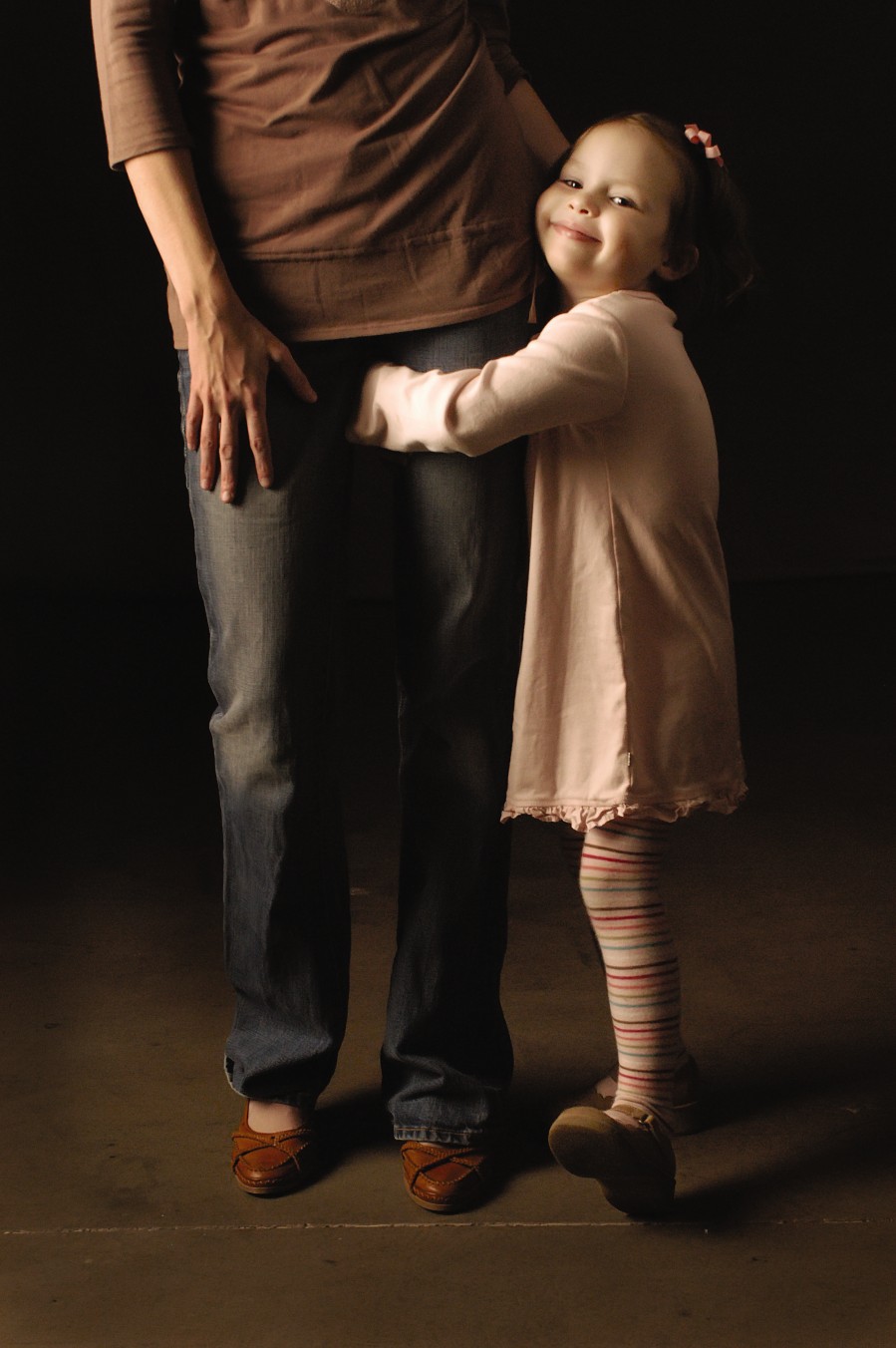
1-1
ABOUT THIS PHOTO Children can be among the most challenging and rewarding of photographic subjects. Taken at ISO 100, f/3.5, and 1/250 second. ©Allison Tyler Jones / www.atjphoto.com
Before you dive headfirst into the art and business of photography, think about what draws you in and what your aspirations are as a photographer. Taking time to evaluate your goals and motivations will inform every decision, whether it’s the type of equipment you need or the kind of business you might want to have.
“A photographer’s work is given shape and style by his personal vision. It is not simply technique, but the way he looks at life and the world around him.” ~Pete Turner
Ask yourself questions such as
• Are you happy simply recording your immediate and extended family history and your friends’ lives?
• Do you love to find the beauty and complexity in things around you?
• What type of photographer are you and where are you now?
• Do you have enough technical skill to feel confident charging for your services or do you have a passion to photograph children as more of a hobby at this point?
If you are considering photographing children as your career and don’t feel a draw or some sense of enchantment toward little ones, you would be much better off finding another subject or specialty.
Be Inspired
Whether photographing children for fun or profit, paying attention to your creative journey, past and present, helps you develop your own individual style or signature. That signature enables you to create more captivating, inspiring, and authentic photographs.
A Note to Parents
A large percentage of photographers who decide to photograph children, either as a hobby or a vocation, do so when they become parents. Suddenly nothing is more profound than nurturing and observing your perfect and beautiful creation. Watching his or her every move and expression, the softness of the cheeks, and the miraculous achievements made each day is awe-inspiring. Using the downtime with a baby or young child and taking advantage of these precious moments enable you to begin to really see this child. Morning light through the window, sleepy eyes, and grateful smiles suddenly become your favorite subjects. Maybe you are a new parent now reading this book for ideas on ways to better capture your own child. Relax and enjoy the pleasure of making simple and spontaneous images of your child.
Who has a better potential to photograph your child than you? If you’ve ever taken your child to a mass-merchant photo studio to have his or her picture taken, you know that those photographers aren’t exactly tuned in to the individual child. As a parent, you have the inside track on your child’s expressions, moods, and quirks. You have access to your child 24 hours a day, allowing you to document the full range of activities, interests, and expressions.
But don’t forget, your child also has the inside track on you. Somehow, kids just know how to push their parents’ buttons, and a friendly photo shoot can go from, “Come on over here, sweetie, and let’s take your picture” to “Stop touching your brother! Do you want a timeout?” Before you know it, you’re ready to send them all to their rooms all because you wanted a nice photo for you to remember how much you love your kids.
And so, a caution to all parents out there: Remember why you’re taking these photographs in the first place. Be patient with those little ones (even when they aren’t so little anymore). When you’re first learning about photography, you can be so worried about “getting the shot” that you forget to be in the moment with your child. Maybe one time you could photograph the neighbor’s children and alternatively, she could photograph yours. You know you’ll be nicer to her kids than you are to your own; they’ll be on their best behavior too — for a while anyway!
If you were to ask ten people to photograph the same child in the same environment, you would see ten different approaches and styles, because the eyes of the photographer are inevitably filtered by past experiences and personal vision (whether the photographer knows it or not). So why not hone in on this tendency and begin to develop your own vision and style?
As you discover different styles of portraiture, you might wonder how different effects are achieved. Chapter 6 explores the most common types of children’s portraiture, from classic studio work to the emerging popularity of environmental portraits. Chapter 11 gives you some creative post-production tips to enhance your photographs and help create your style.
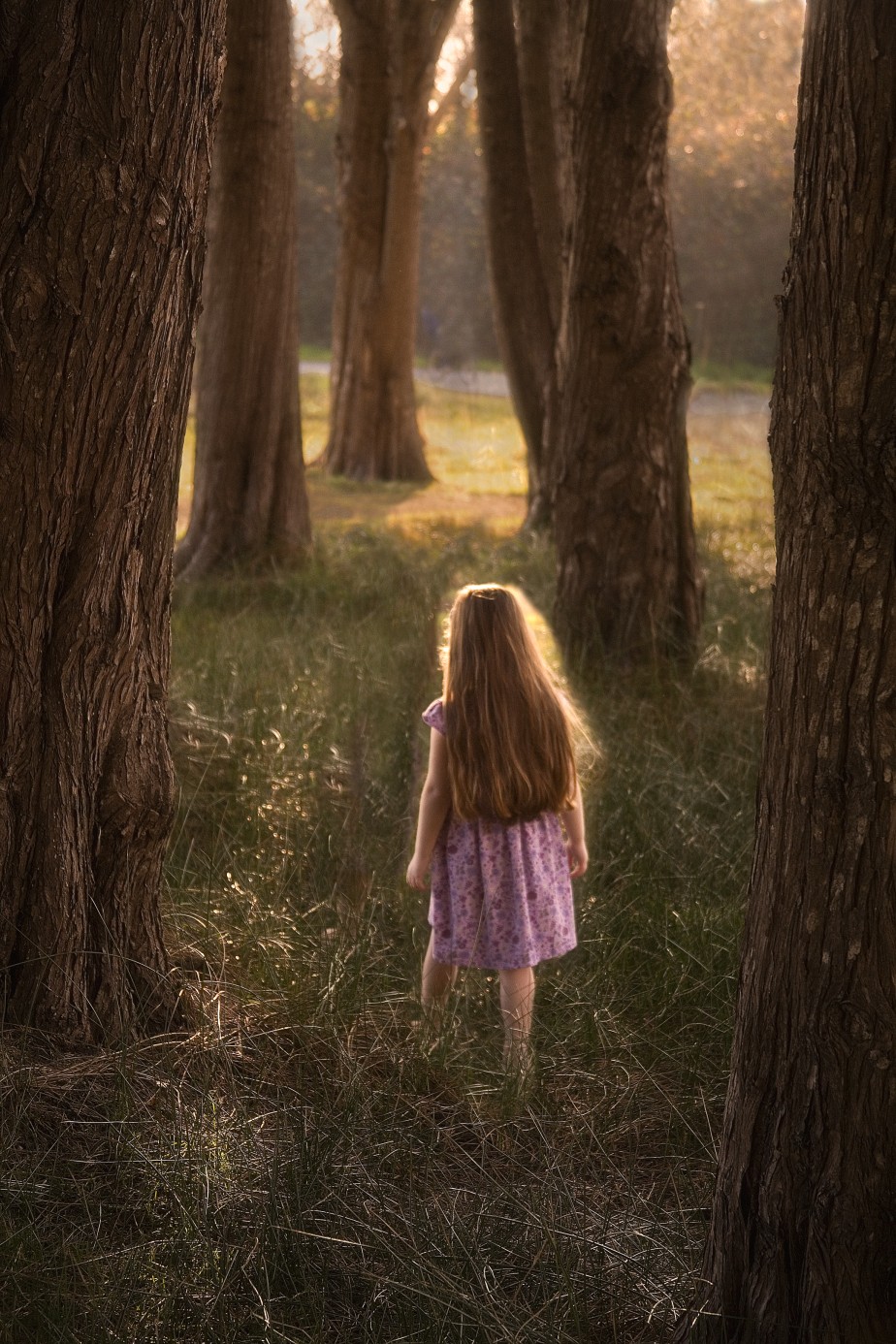
1-2
ABOUT THIS PHOTO I was inspired by lovely late afternoon light and a cooperative and romantic child to add my own style to this image. Taken at ISO 640, f/5, and 1/200 second. ©Ginny Felch / www.photographingchildren.com
A good place to start is by studying the masters of the art of photography and painting. Absorbing the work of other photographers and artists can help you see what you do and don’t like, which is the very beginning of identifying your own style.
Nothing is wrong with learning the way of the masters as you amble along your path. But as you do this, honor yourself, as you have embedded in your soul your own style and vision, which is fervently waiting to be noticed and tapped in to.
“Art is not so much a matter of methods and processes as it is an affair of temperament, of taste, and of sentiment...in the hands of the artist, the photograph becomes a work of art...in a word, photography is what the photographer makes it — an art or a trade.” ~William Howe Downs
Along the way, go ahead and learn the skills and approaches of others, but eventually your very own style will begin to surface and resound. Yes, traces of this mentor or that mentor might show up in your images, but your own vision will shine through, as in 1-2. In fact, you couldn’t hide it if you wanted to.
The photo in 1-3 is a new take on an old subject, the family portrait. Taking the best of classic portraiture combined with new elements of more photojournalistic style, this photo of a young family says something fresh and interesting about their lives together. This lifestyle photography has become a very popular style.
Do you ever take the time to think about what inspires you deeply? Do you love the mountains, the beach, or midtown Manhattan? Are you a dreamer or an athlete? Are you an avid reader or art aficionado? Do you love movies, bicycle rides, or traveling to Indonesia? All of your tastes, your passions, and your fascinations are what make you unique and who you are. Never take this for granted; in fact, refining, developing, and acknowledging your tastes and passions all contribute greatly to your creativity.
Looking around your home might give you some clues as to what inspires you and what you love. Do you have a style? Is there a consistency to what is around you; for example, a theme such as nature or the arts? Are you surrounded by colors and textures that you enjoy? Maybe you haven’t seen the details in your home as a choice, and pieces have been dictated by what was free, inherited, or chosen by others. Do you realize how much you are influenced by your surroundings? They feed into you, either negatively or positively, on a daily basis. Would you choose to photograph your surroundings, or do you have to go to another location or country to be inspired? Would you photograph a child in your home? Whose home would you prefer, and why?

1-3
ABOUT THIS PHOTO A new take on the family portrait. Combining a more candid casual feel, this photographer has put her own spin on a timeless photographic tradition. Taken at ISO 2000, f/6.3, and 1/60 second. ©Mary Schannen / www.melangephoto.com
Many people believe that they don’t have the choice to influence their physical environment for a myriad of reasons. However, your surroundings are a very important part of your creativity, so take steps every day to pay attention to what you create around you. This pays off when you design your photographs.
Another source for the roots of your creativity might be to remember what inspired you as a child. What did you have around you, in your bedroom, for example? Did you have collections? Can you see a theme running through any of your knickknacks? Did you have a favorite toy or a favorite place? In a whimsical portrait of a little boy in 1-4, the photographer brings back memories of her own childhood collections.
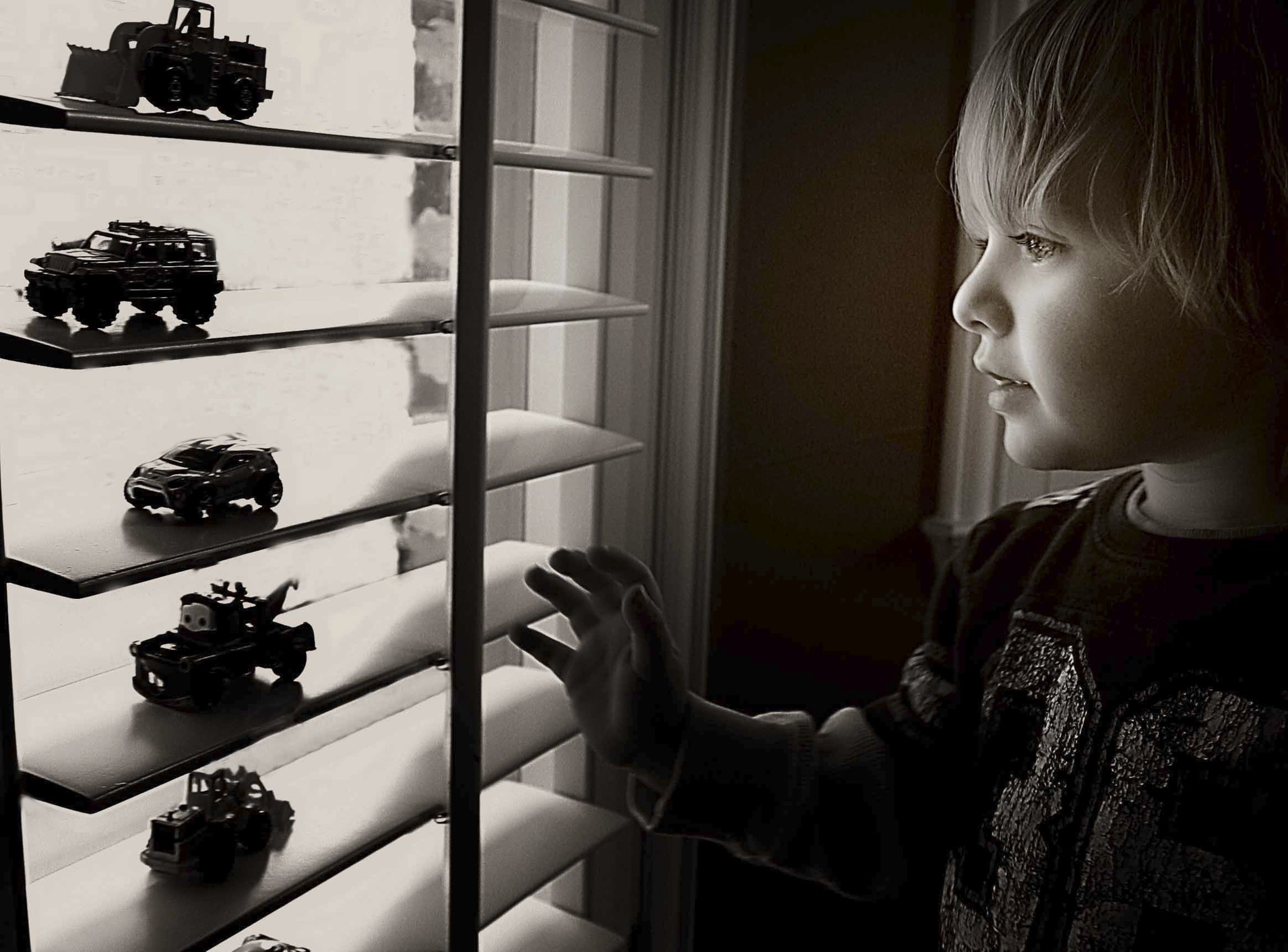
1-4
ABOUT THIS PHOTO. Beautiful, contouring light from a bedroom window highlighted the photographer’s son’s face and his treasured model collection. Taken at ISO 400, f/4, and 1/50 second. ©Mary Schannen / www.melangephoto.com
Resources for Inspiration
Living an enriched life, living as fully as possible, and drawing from your intuition for guidance significantly affect what reflects back in your photographic images. As a photographer of children, these things can affect your attitude, your taste, and your inspiration for creating more artistic and meaningful portraits. Here are some ideas that you might consider for further exploration.
• Attending workshops. Nothing is more inspiring than spending days or a week with a group of fellow photographers, as in 1-5. The environment of sharing and cooperation in moving your photography forward is very motivating. Away from the demands of family and work, you are in a very special and protected place. From personal experience and reputation, I recommend Maine Photographic Workshops and Santa Fe Workshops for hobbyists and professionals alike. Professional trade organizations such as Professional Photographers of America (www.ppa.com) and its local affiliates hold lectures and workshops throughout the year, many of which focus on the business of photography.
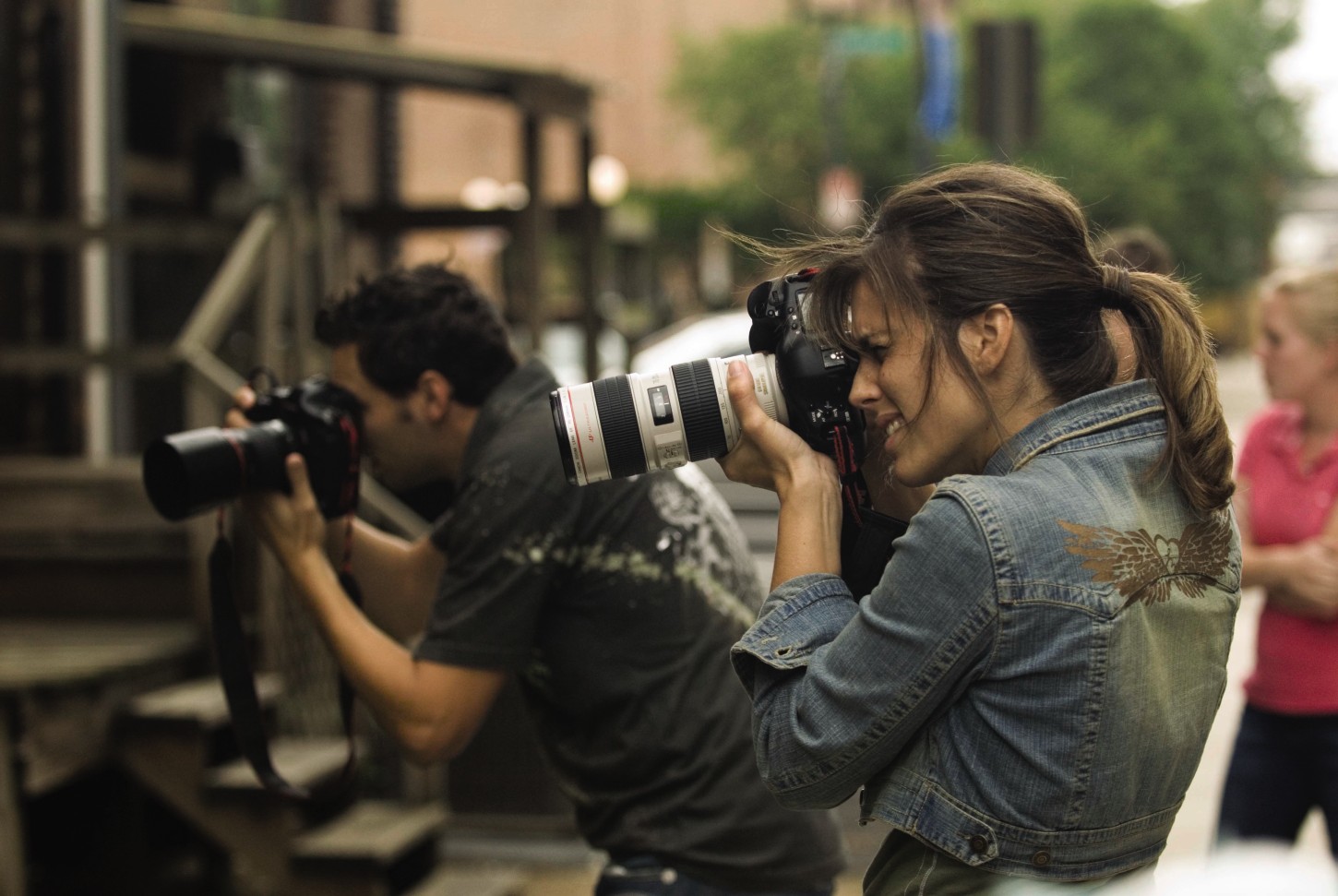
1-5
ABOUT THIS PHOTO Photography workshops are a great place to get some hands-on practice. Taken at ISO 200, f/2.8, and 1/125 second. ©Allison Tyler Jones / www.atjphoto.com
• Working with mentors. Many accomplished photographers are willing to mentor photographers who are newer to the craft. Mentoring is more hands-on and longer term than just taking a workshop. Because it is one-on-one, you can really cut to the chase and learn exactly what you wish.
• Reading books. Literature can call you into a sense of place with words alone, tickling your imagination. Books by other photographers can be provocative for aspiring photographers. Books on great artists and their lives speak to you from a valuable point of view and move you with the artist’s creations. Take the time to peruse art and photography books at your local library.
You can find many wonderful opportunities for studying with photographers you admire online. See Chapter 11 for a resource list.
• Reading magazines. Magazines can motivate you by keeping you current on styles of clothing and imagery. Whether it’s a GapKids ad or an editorial about child rearing, every page can give you new ideas on photographing children. These resources can give you insight into contemporary styles that might influence your work. Clip your favorite photos and start an idea file to inspire you when your motivation is running low. Notice how your collection changes as you move through the months.
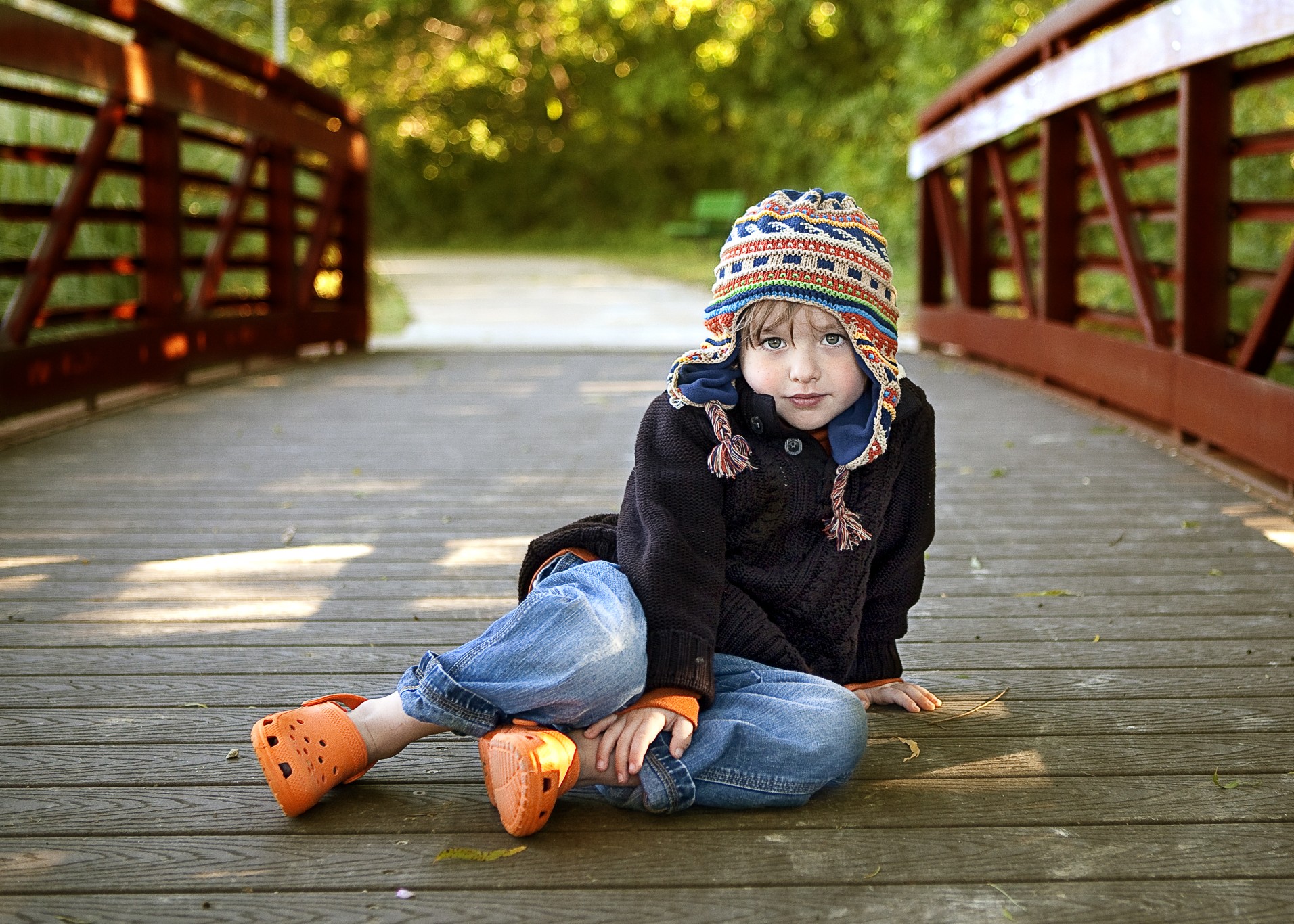
1-6
ABOUT THIS PHOTO Keep current on all the latest trends in children’s photography by joining an online forum of photographers. Taken at ISO 640, f/2.8, and 1/60 second. © Mary Schannen / www.melangephoto.com
When you are watching a movie, view the bonus features on the DVD you are watching. Study lighting setups in the movie scenes to get great ideas on how to light your own work. Or just pay close attention to the lighting and composition in the next movie you attend. Notice how each frame is composed just so. Movies directed by Martin Scorsese and Akira Kurosawa, among others, are known for their masterful lighting. You will begin to see how important light and composition are to create a mood and tell a story.
• Visiting museums and galleries. Author and artist Julia Cameron encourages all artists to have “artist’s dates” frequently. It is one thing to visit a museum and quite another to go with the intention of keeping your eyes wide open for inspiration. Taking another artist friend along can make it a fun adventure and influence your work in new ways, such as inspiring you to use new colors, compositions, and forms of light.
• Exploring culture. Theatre, ballet, and opera can open your eyes and lead you to new ways of thinking and seeing. With a photographer’s eye, watch the delicate and sophisticated lighting used to dramatize dance and theatre. Notice the gestures, movement, costumes, and fabrics. These observations might move you to experiment. The performing arts may influence you to seek out more dramatic lighting situations and backgrounds for your portraits of children.
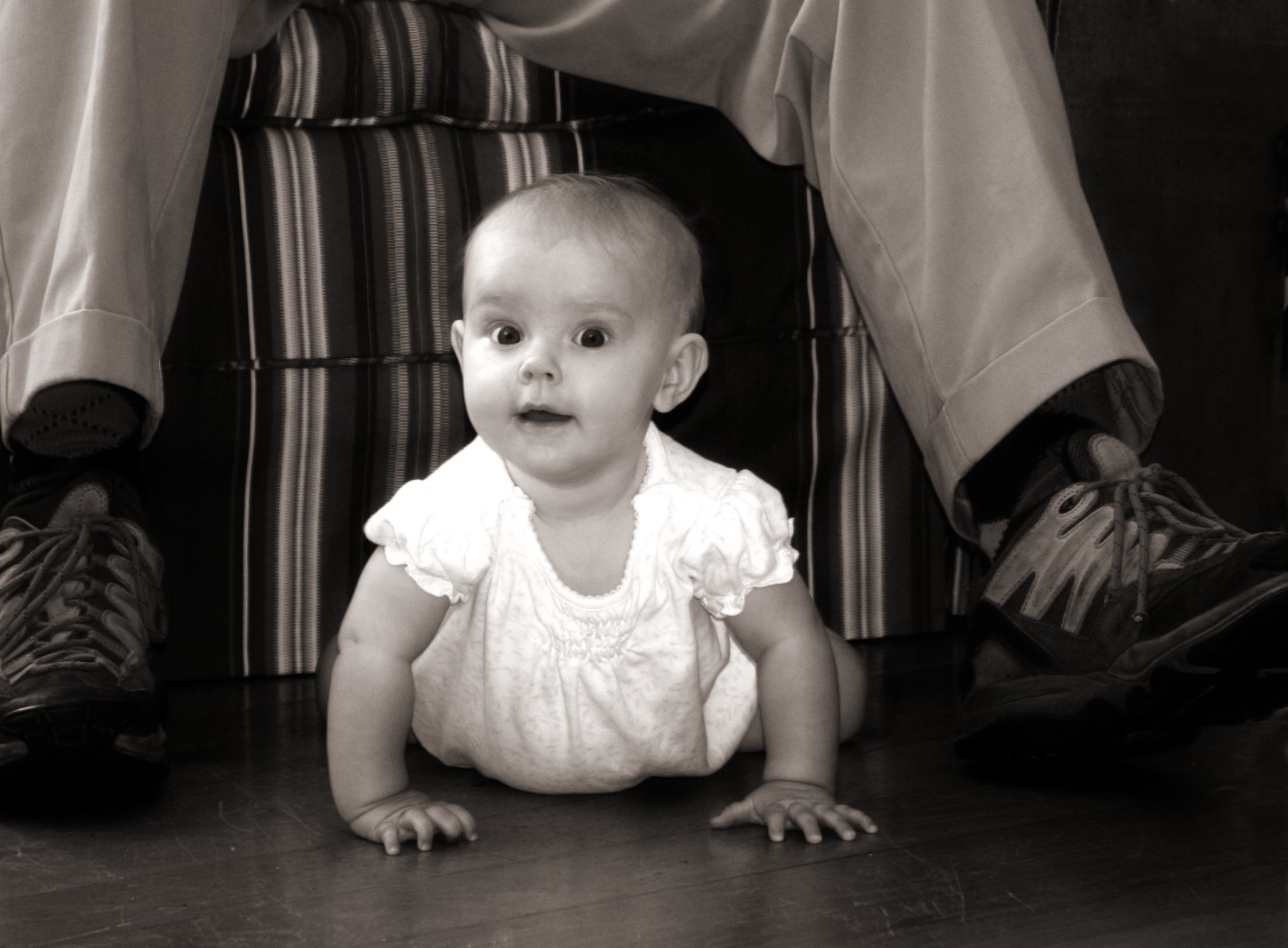
1-7
ABOUT THIS PHOTO I couldn’t resist this opportunity at a family reunion when I saw my little great neice so tiny next to Gumpaw’s feet! Photographing from ground level offers whimsical backgrounds and can surprise and delight the subject. Taken at ISO 400, f5.6, and 1/60 second. ©Ginny Felch / www.photographingchildren.com
• Traveling. An olive tree in your front yard doesn’t hold a candle to one in Tuscany — it just doesn’t! Moving outside of your everyday environment makes you not only appreciate the styles and light of other cultures, but also your own environment. New colors, new faces, styles, architecture, food, and foliage expand your vision at every turn. Observe children of other cultures, their clothing and their activities. When you arrive back home, you are forever changed, and you won’t be able to help seeing your environment differently. These are experiences that imprint your cells and change you forever, feeding your spirit and your vision.
Try this creative exercise: Make 20 photographs that include a child and contain one of the following elements: Texture, harsh light, color, junk as art, a window, a face, shadow, reflection, round, smooth, and partnership.
• Checking out the Internet. Bookmarking your favorite photographer’s websites or blogs is the way to keep a virtual idea file. Join an online forum to share your work in a cooperative spirit with other photographers from around the world. The critique and encouragement from these forums can help you improve very quickly. The Internet is so of-the-moment, giving you access to the latest trends in child photography, such as the contemporary-style portrait in 1-6. You could spend days on Flickr perusing photographs of children and finding great inspiration!
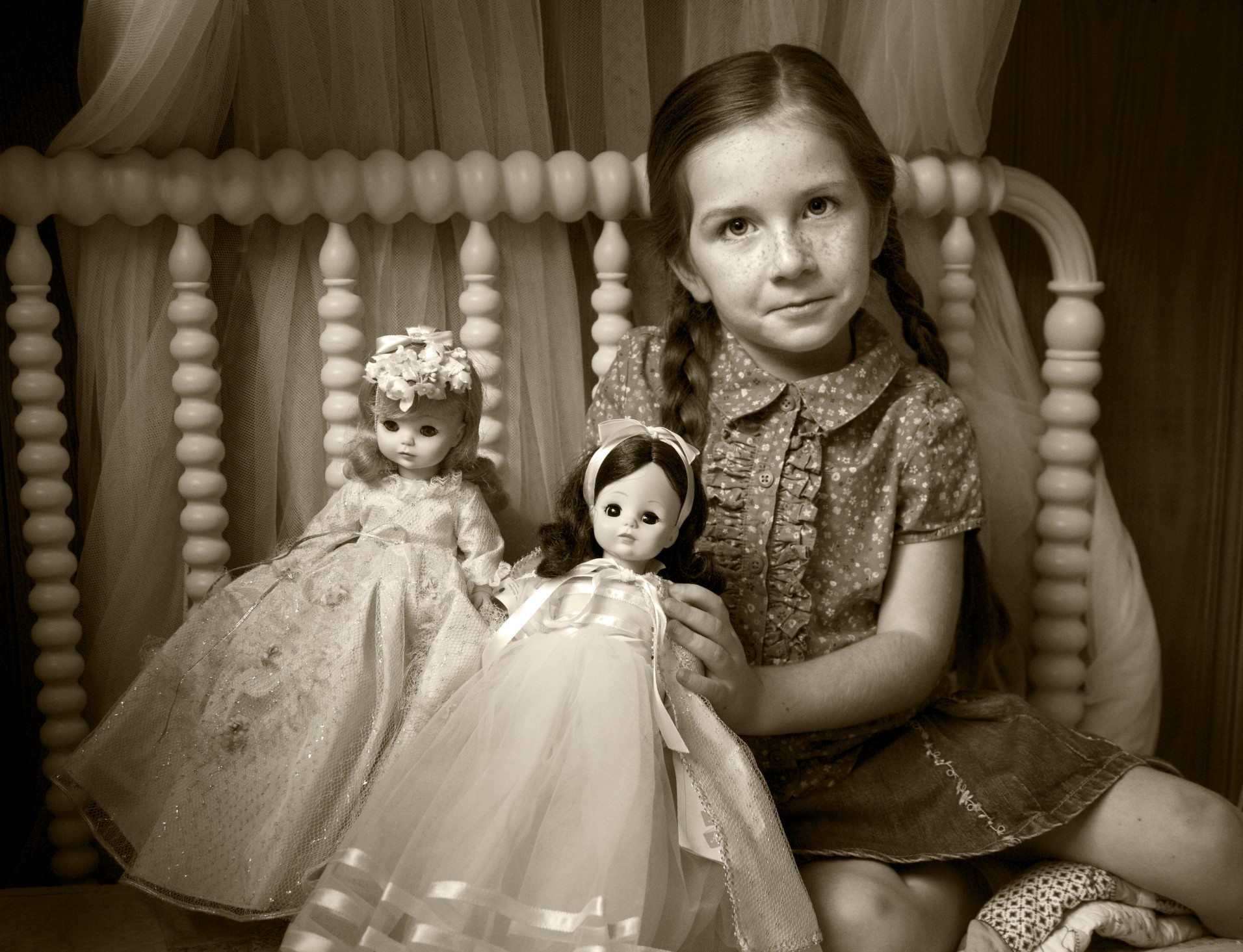
1-8
ABOUT THIS PHOTO I was deeply enamored with dolls as a child, and was invited to share the passion with Daisy. Taken at ISO 1600, f/5.6, and 1/100 second. © Ginny Felch / www.photographingchildren.com
“Pretending is a great way to exercise our imagination. Pretending takes us back to our kidhood...it unleashes our creativity.” ~Kevin Eikenberry
• Doing creativity exercises. You don’t have to take a class to do creative exercises. Make up your own using all the inspiration you’ve gathered from the previous suggestions. Choose your own subjects, but narrow it down, be specific, and work within a timeframe. Join in with friends to work on creative exercises and share the results on a blog or Facebook. Work your way through the assignments at the end of each chapter in this book and you might be surprised at how you start examining and appreciating what you see every day and how that influences your work.
“You don’t have to travel to see. One of my favorite assignments is to shoot a roll of film within 20 feet of your bed.” ~Ruth Bernhards
The Importance of Play
Can you remember how important playing pretend was when you were a child? It was a natural part of playing, whether it was about cowboys, Star Wars, or dolls. Almost everyone eventually learned that pretending was for children and sacrificed this behavior for the sake of growing up. Time to turn back the clock!
Your ability to play is an essential skill when photographing children. When you get down low, at the child’s level, as in 1-7, viewing life from this perspective and entering into the child’s world, how can your photography not be influenced?
Children, as a whole, are very good judges of character and can detect a phony a mile away. If you really aren’t interested in them or are intimidated by them, they know it. Take the time to sit with them and let them get used to you. Ask the child to show you her room, as in 1-8, or her favorite toys. Children are no different from adults in this aspect; they like people who are genuinely interested in them. Ask them about school and their teachers, friends, and interests. Let them look over your camera and show them a few shots throughout the shoot so they feel a part of what is going on. If you are working with a particularly timid child, allow this child to first get comfortable by letting her stay with Mom or Dad, Grandma, or a babysitter, for a bit, as in 1-9, before she is expected to perform for you. In this case, a whole new story was told.
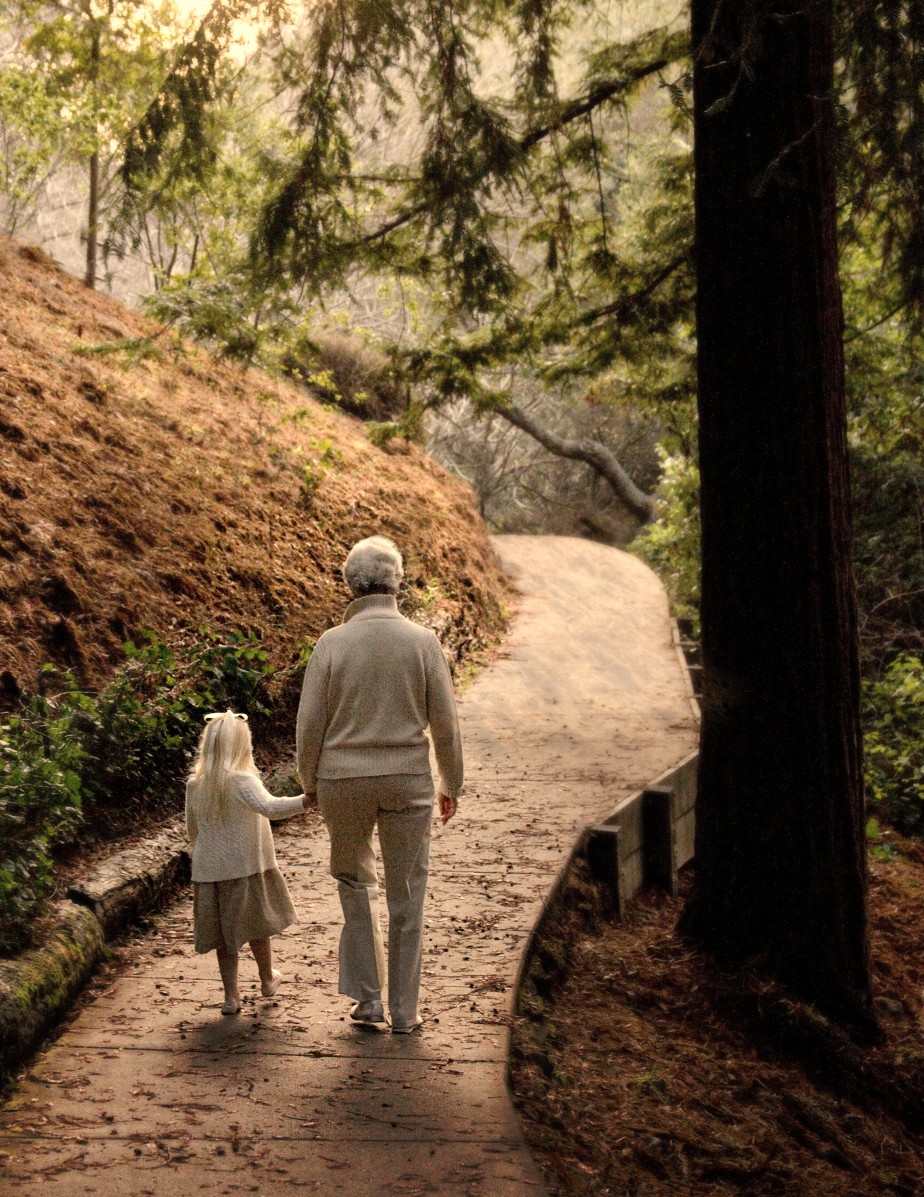
1-9
ABOUT THIS PHOTO Grandmother came along on the shoot to help with the children. Even though the children were the intended subjects, I couldn’t resist capturing this pictorial scene, focusing on the close and trusting relationship. Taken at 1600, f/5.6, and 1/200 second. ©Ginny Felch / www.photographingchildren.com
Taking time to play a little and see the world from the perspective of the child you are photographing can only help you expand your vision in capturing real and touching images. Spending a little time on the floor can change your viewpoint not only by putting yourself at the child’s level but also by allowing you to explore new angles and approaches to your subject. Take the chance! You might like it down there!
Assignment
Show Us Your Style!
You should understand that who you are and what has inspired you shine through in the portraits you create. After reading this chapter, you have probably given some thought as to what influences you, what your tastes are, and what your passions are. Now that you are more aware, create a children’s portrait that reflects some of who you are and your style. You can show this through your choice of colors and tones, clothing, background environment, or general attitude. Use your imagination and try to come up with something really unique, something that separates you from the crowd.
Living by the beach opens up great possibilities for photographing children and families. In this photograph of an extended family of young people, the atmosphere was relaxed and comfortable, inspired by my lifestyle. I am definitely influenced by summering on Cape Cod as a child, and I am now known for beach portraits. Casual and relaxed, this portrait of first cousins was thought out ahead of time to achieve color harmony. I spoke with the family about wearing clothing that would create a sense of unity in their style. Taken at ISO 400, f/9, and 1/800 second.

©Ginny Felch / www.photographingchildren.com
Remember to visit www.pwsbooks.com after you complete this assignment and share your favorite photo! It’s a community of enthusiastic photographers and a great place to view what other readers have created. You can also post comments, read encouraging suggestions, and get feedback.

